By ROB FREESE
When I say “1980s slashers,” everybody knows exactly what I mean. But when I say “1980s action slashers,” it’s blank stares as far as I can see.
Hollywood sells its products in easily recognizable genres, so at a glance, ticket buyers know what is playing. While horror fans tend to like their films to stay in their lanes, it’s fun to go off-roading on occasion, with a flick that mixes a genre or two. After slashers began making huge profits on small budgets, they were on Hollywood’s radar, and the studios milked them dry in a relatively short time. 1981 was the slasher movie’s biggest year. Although they persisted, limping to the decade’s close with a trio of poorly received franchise sequels (A Nightmare on Elm Street Part V: The Dream Child, Halloween Part V: The Revenge of Michael Myers and Friday the 13th Part VIII: Jason Takes Manhattan), there were still successful slashers that pumped life – and mega bucks – into the subgenre. Although traditional slashers began losing ground at the box office, producers were not afraid to blend slasher motifs into other genres. Most fans know about the slasher spoofs – Student Bodies, Wacko, Pandemonium, National Lampoon’s Class Reunion, Unmasked Part 25 – but I suspect few are as well-versed on action slashers.
SILENT RAGE (1982)

Badass Texas sheriff Dan Stevens (Chuck Norris) and his comic-relief sidekick, Charlie (Stephen Furst), are on the case. Stevens lets his fists do the talking. After Kirby is apprehended, he breaks free, prompting the assembled police force to use him for target practice.
Miraculously, his adrenaline flowing nonstop, Kirby survives. He’s whisked off to Dr. Halman’s experimental clinic, where Dr. Spires (Steven Keats) and Dr. Vaughn (William Finley) convince Halman to inject Kirby with an untested rejuvenation formula, Mitogen 35. You know, to see what happens…
Revived and pissed off, Kirby proves to be practically unkillable (his body regenerates at an accelerated rate that would make Jason Voorhees envious), and he starts murdering in slasher fashion before going mano a mano with Sheriff Dan.
Kirby stalks silently, killing in the tried-and-true fashion of Jason or Michael. When there’s no nearby weapon, he’ll squish a skull or snap a neck or use an axe or giant hypodermic needle when handy. There is a lot of cat-and-mouse with victims, as well as a quick game of “find the dead bodies.” Libby plays Kirby with complete emotionlessness, imbuing his face with a mask-like appearance. (And his silver jumpsuit gives him the fun, distinctly ’80s vibe of a new wave psychopath.)
A similar premise was explored a year earlier in Joe D’Amato’s Absurd. (That Italian take on Halloween II and the Super Bowl didn’t reach the U.S. until its video release in 1986 as Zombie 6: Monster Hunter.)
Silent Rage tries hard to mix slasher thrills with high-kicking Chuck Norris action, but succeeds in coming across uneven and undercooked. The comedy bits don’t help, and in one bizarre scene, Furst recounts a story about accidentally killing a dog when he was young.
Scriptwriter Joseph Fraley wrote himself into a corner when he couldn’t think of a way to kill his psycho. With no vulnerabilities, the movie just ends, which is frustrating as hell. (If this was for the benefit of a sequel, it never happened.)
Coming off the Great Slasher Tsunami of 1981, this looks and feels like a genuine knife-kill flick of the era. William Finley had been seen previously in The Funhouse, while Stephen Furst played the man-baby menace in The Unseen, and Desmond Dhooge was in the S.F. Brownrigg proto-slasher Keep My Grave Open. Director Michael Miller’s next film was the slasher spoof National Lampoon’s Class Reunion.
10 TO MIDNIGHT (1983)
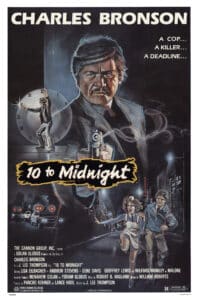
Bronson is Detective Leo Kessler, a hard-nosed detective who breaks every rule. Paul McAnn (Andrew Stevens) is his bumbling, idealistic new partner who has eyes for Kessler’s student nurse daughter Laurie (Lisa Eilbacher). Warren Stacy (Gene Davis) is the good-looking but socially awkward office worker who sees his female coworkers as less than human. When they reject his advances, he stalks them, then strips down to his birthday suit and slaughters them in gruesome fashion.
Stacy is meticulous in his stalking of co-worker Betty (June Gilbert). First, he attends a retro screening of Butch Cassidy and the Sundance Kid and harasses two girls. Being extra obnoxious so they won’t forget him, he sneaks out, finds Betty with her boyfriend bumping uglies in a van in the woods and brutally kills both of them – in the nude.
Once Kessler lays eyes on Stacy, nothing will change his mind that the geek is his man. He goes so far as to plant evidence, only to have to admit to doing so before McAnn is called as a witness during the trial. Enraged, Stacy tracks Laurie to the apartment she shares with three other student nurses and goes into full-blown slasher mode, slicing and stabbing his way through them as he pursues Laurie.
The film’s climax is a fan favorite. (Of course, it plays up Bronson’s connection to the Death Wish films, and fans cheered Kessler’s shoot-first-ask-questions-later credo.) Davis does well and doesn’t shy away from the added kink of stalking his prey in the buff. It adds an unsettling quality, but it doesn’t seem like a sound way to avoid detection from forensics.
Director J. Lee Thompson brings a polish to the production that could have been sleazier in lesser hands. The slasher vibe is stronger in this film than in most on this list. The film works much like some of the “big city slashers” like Visiting Hours or Night School, while also echoing Don’t Answer the Phone and Don’t Go in the House.
The cast is packed with slasher legacies: Andrew Stevens starred in Massacre at Central High and played a similar creeper in The Seduction. Gene Davis was in William Friedkin’s Cruising, and Wilfred Brimley was featured in Death Valley. Robert F. Lyons was Skeeter in Dark Night of the Scarecrow. Jeana Keough was in Double Exposure. Arthur Hansel was in the sort-of-proto-slasher Mary, Mary, Bloody Mary, Sam Chew Jr. appeared in the sort-of-sci-fi slasher Time Walker, and Barbara Pilavin was in the sort-of-supernatural slasher Frightmare. And of course, Thompson directed the 1981 knife-kill whodunit Happy Birthday to Me.
ANGEL (1984)
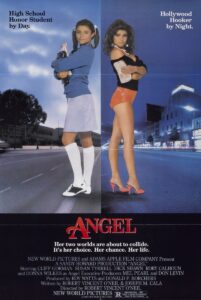
Diehl, identified only as “the killer,” turns in a silent performance until the film’s final moments. He perpetrates his crimes with a switchblade, brutally cutting up his victims. When he becomes desperate during the climax, he resorts to using a pistol. This one has a lot of cat-and-mouse and “find-the-bodies” action.
Director Robert Vincent O’Neil (Blood Mania) populates his flick with quirky Hollywood Boulevard denizens, giving the film its crazy energy. Wilkes, who was in Schizoid and Blood Song, is assisted by screen vets and slasher stalwarts Susan Tyrrell (Butcher, Baker, Nightmare Maker) and Rory Calhoun (Motel Hell). Donna McDaniel (Frightmare), Joshua Cadman (Superstition), Dennis Kort, (Massacre at Central High), Peter Jason, (Trick or Treats) and Gene Ross, who was memorable in S.F. Brownrigg’s proto-slasher Don’t Look in the Basement and later appeared in Friday the 13th: The Final Chapter and Halloween 4: The Return of Michael Meyers, round out the cast.
TIGHTROPE (1984)
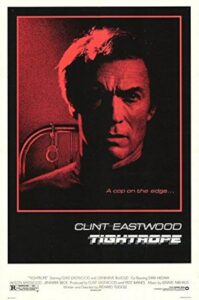
Eastwood turns up his kink as New Orleans detective Wes Block in 1984’s Tightrope. He’s tasked with solving a string of brutal slayings in the French Quarter, and each victim is revealed to be one of his recent bed partners. As the killer’s brutality increases, Block begins trying out some of the killer’s kinky habits and experimenting on the unknowing victims. The creep in question, Leander Rolfe (Marco St. John), is a prior perv Block busted eleven years earlier. Rolfe is out and murdering those responsible for putting him away.
Tightrope works the same as 10 to Midnight, existing in that “slasher-esque” realm with The Town that Dreaded Sundown. This is not an easy movie to watch. Although Eastwood was a legit action hero, this film keeps the Dirty Harry thrills to a minimum and the screen drips with depravity. (It is honestly difficult rooting for Eastwood in this one.)
Rolfe is always nearby, following Block everywhere. We never see his face. He either stays in the shadows or is masked. (The most chilling encounter comes when Rolfe, dressed as a clown, confronts Block’s young daughters at a street fair.)
This one wallows in slasher tropes: the silent, masked killer, the footwear that identifies the killer, finding the bodies after the murder (sometimes hidden in places like a clothes dryer) and a mean streak that marks many of the big city slashers like Eyes of a Stranger and The New York Ripper.
MURPHY’S LAW (1986)
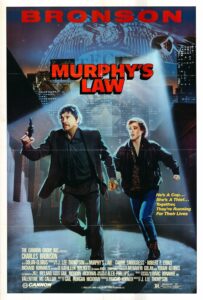
When Murphy is forced to clear his name for the murder of his ex-wife, he goes on the run with foul-mouthed delinquent Arabella (Kathleen Wilhoite), who helps Murphy stay alive. Psycho Joan Freeman (Carrie Snodgrass) murders in different ways, including electrocution, strangulation, stabbing and in the finale, when she’s hunting Murphy in the famed Bradbury Building, crossbow.
Because the protagonist is stalked by a female aggressor, the film offers an unusual and fresh spin on the psycho-on-the-loose plot. Snodgrass is effective, especially when her psychiatrist checks in on her: Joan is exercising vigorously, telling her doctor everything is fine. Her performance recalls Nicholas Worth’s character in Don’t Answer the Phone, constantly exercising. Snodgrass is cold and calculating. And her intensity makes her a memorable lunatic.
COBRA (1986)
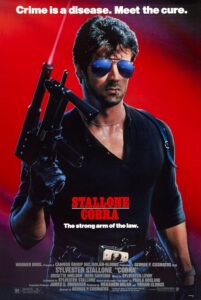
As the Night Slasher, Thompson is damn menacing. He’s a Jason Voorhees type, and when he leads the early attacks on victims, carving them up with his custom-made cutlery, the flick generates the slasher movie-style scares. Of course, this is 1986, when Stallone was riding the successes of 1985’s Rambo: First Blood Part II and Rocky IV, and because it was produced by Cannon, Cobra is extreme in every wonderful way possible.
HERO AND THE TERROR (1988)
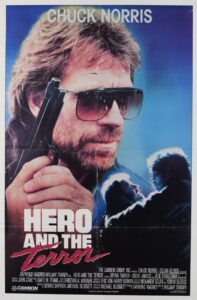
Years later, O’Brien suffers nightmares and PTSD from apprehending Moon. He’s now in a relationship with his therapist, but when Moon breaks out of prison, O’Brien is on high alert. He tracks the murders (resembling Moon’s MO) to the giant Wiltern Theatre, where Moon has been snapping necks and dragging victims through the ventilation ducts. When friend and fellow cop Bill Robinson (Steve James) is killed, O’Brien enters the theatre one last time for a little face breaking with Moon.
Hero and the Terror is disjointed and seems to have an identity crisis. Director William Tannen mixes slasher and action thrills with a ton of unnecessary humor. (Was Chuck prepping for his ’90s comedies Sidekicks and Top Dog? )
COMMANDO (1985)
Honorable mention goes to Mark Lester’s 1985 Arnold Schwarzenegger, bullets-and-blood banger, Commando. While there is nothing slashery about the plot, there are two scenes worth talking about. The first comes when retired Special Forces operative John Matrix (Schwarzenegger) prepares to travel to the bad guy’s island lair and go to war. The edits are quick, highlighting each death-dealing weapon in a satisfying – and oddly fetishistic – manner. Quick cut close-ups of semi-automatic pistols being readied and 18-inch survival knives being plunged into their sheaths succeeded in getting the audience pumped up for the rambunctious manslaughter to come. This scene was completely lifted from Joe Zito’s The Prowler, where the WWII slasher prepares for his long night of slaughter in an identical fashion.
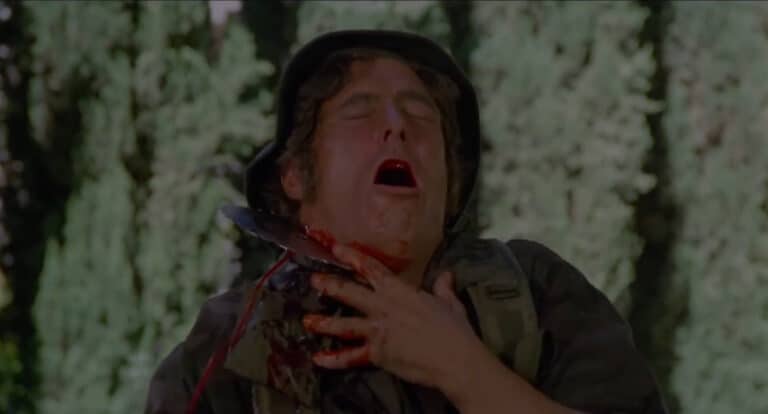
Arnold’s gory handiwork in “COMMANDO” (1985).
Another scene seems to be included especially for hack-and-slash fans, when the villain’s army traps Matrix in a gardener’s shed. Even in the extended cut, this tool shed massacre is under a minute in length, but it delivers more interpersonal mayhem than many full-length slashers. Matrix employs a pitchfork, double-bladed axe, and, in an amazing moment of creativity, circular saw blades thrown like frisbees. It is a glorious moment of slasher-style limb lopping and widow-making.
THEY CALL ME MACHO WOMAN (1989)
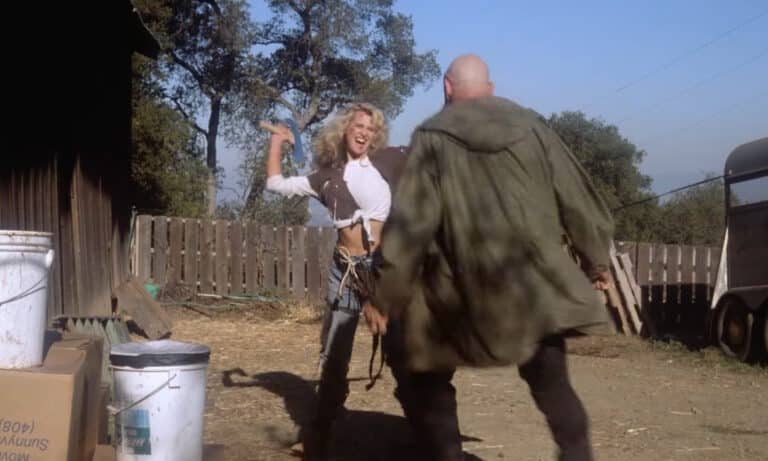
Debra Sweaney delivers justice, TROMA style, in “THEY CALL ME MACHO WOMAN” (1989).
Another honorable mention: TROMA‘s They Call Me Macho Woman! (aka Savage Instinct). The story begins like a cocaine-fueled The Hills Have Eyes mixed with a pinch of I Spit on Your Grave before detouring into an “anything goes” action flick. Taken captive, Susan Morris (Debra Sweaney) is groped and abused but keeps her cool, outsmarting her abusers time and again. Nearing the final reel, she is locked in a shed. That’s when Susan makes one of the most badass moves I’ve ever seen in an action movie. She collects a bunch of rusty weapons, sharpens and shines them to a mirror finish, fashions some leather armor and takes on her abusers the ’80s way. (She builds her weapons like Freddy assembling his glove during the opening credits of A Nightmare on Elm Street, then gears up, a la Commando by way of The Prowler.)
They Call Me Macho Woman! features a brief moment not unlike the tool shed scene in Commando, asSusan buries axes into chests and craniums and pins eyeballs to brains with twelve-inch spikes. It is the kind of murderous action to make the Cropsy Maniac or Madman Marz fall instantly in love.




Would Texas chainsaw massacre 2 qualify as actiion/slasher?